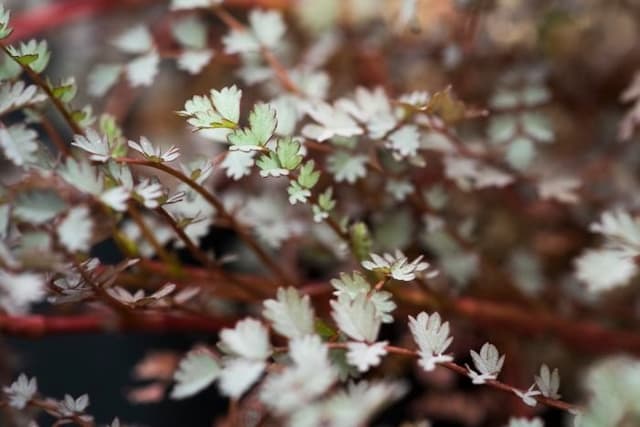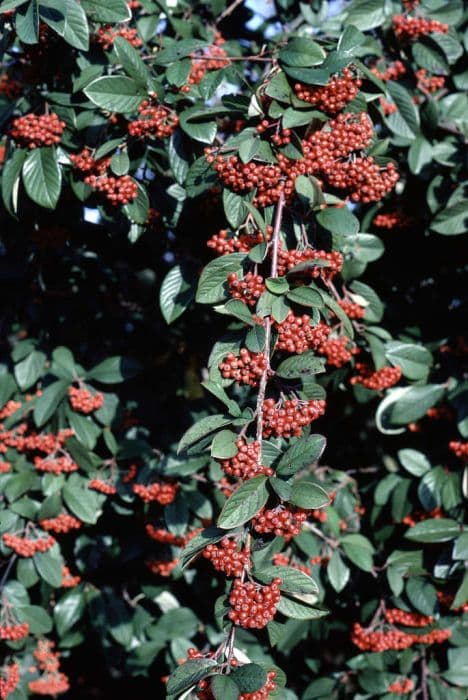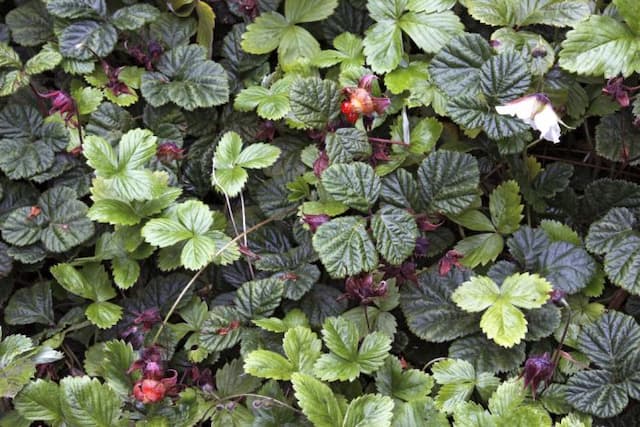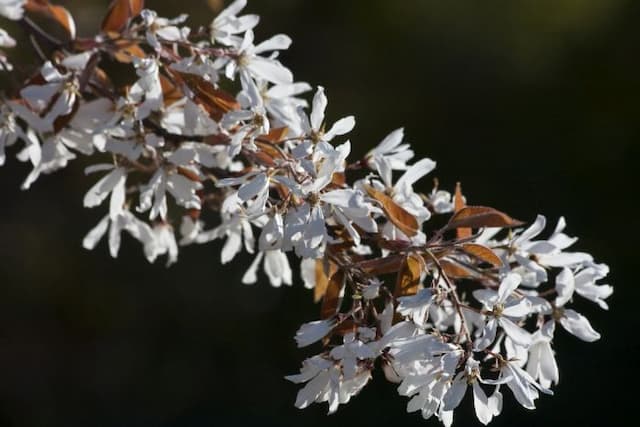Flowering quince Chaenomeles speciosa
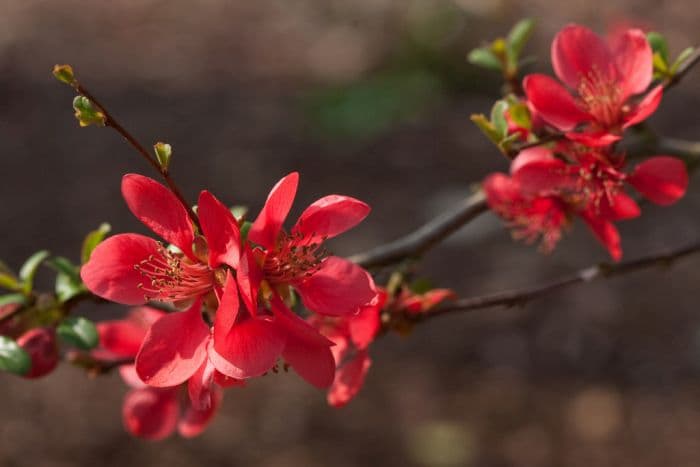
ABOUT
The plant commonly known as flowering quince is a decidomatic shrub that is widely appreciated for its striking spring blossoms. The plant typically produces a profusion of flowers that range in color from white to pink to red, often appearing before the foliage fully emerges. The blossoms are composed of five petals and are notable for their vibrant hues. In addition to its attractive flowers, the flowering quince has glossy green leaves that transition from a reddish hue when they first emerge to a lush green as they mature. The leaves are commonly oval-shaped with a smooth or slightly serrated edge. The branches of the plant can be somewhat thorny, bearing the flowers and later on small, apple-like fruits that ripen to a yellow or greenish color. The fruits are fragrant and can be used in preserves and jellies. Overall, the flowering quince possesses a dense growth habit, and its tangled branches give it a bushy appearance that contributes to its visual appeal in garden settings.
About this plant
 Names
NamesFamily
Rosaceae.
Synonyms
Flowering Quince, Japanese Quince, Japonica, Maule's Quince.
Common names
Cydonia speciosa, Pyrus chaenomeles, Chaenomeles lagenaria.
 Toxicity
ToxicityTo humans
The plant commonly known as flowering quince (Chaenomeles speciosa) is not considered highly toxic to humans. However, consuming large quantities of the seeds could potentially cause issues because they contain amygdalin, which can release cyanide when digested. Symptoms of cyanide poisoning include nausea, vomiting, headache, dizziness, rapid breathing, rapid heart rate, and can progress to more severe symptoms such as convulsions, respiratory failure, and even death in extreme cases. The flesh of the fruit is not toxic and is in fact edible when cooked, but the raw fruit may cause stomach upset because it is hard and astringent.
To pets
Flowering quince (Chaenomeles speciosa) may pose similar risks to pets as it does to humans if they consume a large amount of the seeds. The seeds contain amygdalin, which can be metabolized into cyanide in the stomach. Cyanide poisoning in pets can result in symptoms like vomiting, diarrhea, abdominal pain, difficulty breathing, and lethargy. In severe cases, seizures, coma, or death may occur. As pets might be more likely to ingest larger amounts of plant material, it is advisable to prevent them from eating the seeds of the flowering quince. The fruit flesh, if they happen to ingest it, is not toxic but can cause stomach upset due to its astringent nature.
 Characteristics
CharacteristicsLife cycle
Perennials
Foliage type
Deciduous
Color of leaves
Green
Flower color
Red
Height
6-10 feet (1.8-3 meters)
Spread
6-10 feet (1.8-3 meters)
Plant type
Shrub
Hardiness zones
5-9
Native area
China
Benefits
 General Benefits
General Benefits- Ornamental Value: Chaenomeles speciosa, commonly known as flowering quince, is widely used in landscaping for its beautiful blossoms which add aesthetic appeal to gardens.
- Wildlife Attraction: Its flowers provide an early source of nectar for bees and other pollinators, while its fruit can be a food source for birds.
- Erosion Control: The plant's extensive root system can help stabilize soil and prevent erosion on slopes and embankments.
- Hedging and Screening: Flowering quince is often used in hedges or as a natural privacy screen due to its dense growth habit.
- Drought Tolerance: Once established, it can tolerate periods of low water, making it suitable for xeriscaping or drought-prone areas.
- Low Maintenance: Flowering quince requires minimal care once established, making it a convenient choice for gardeners of all skill levels.
 Medical Properties
Medical Properties- Anti-inflammatory: The fruit of the flowering quince is traditionally used to reduce inflammation.
- Antioxidant: The compounds present in the flowering quince, such as vitamin C and flavonoids, are known to have antioxidant properties.
- Antimicrobial: The plant has been used to fight bacterial infections due to its antimicrobial effects.
- Relief of respiratory conditions: It is employed in traditional medicine to treat coughs and other respiratory issues.
- Gastroprotective: Flowering quince fruit may be used for protecting the gastro-intestinal tract and alleviating conditions like ulcers.
- Managing diabetes: There is some traditional use of the plant in the management of diabetes symptoms due to its potential blood sugar-lowering effects.
- Cardioprotective: The flowering quince is sometimes used for its heart-protective qualities, though evidence is limited.
 Air-purifying Qualities
Air-purifying QualitiesThis plant is not specifically known for air purifying qualities.
 Other Uses
Other Uses- Flowering Quince branches can be used for decorative winter arrangements. Their gnarled, contorted shape offers architectural interest, and their early blooms provide color indoors.
- The fruit's high pectin content makes it useful for setting jams and jellies. Flowering Quince fruit can be added to other low-pectin fruits to help them gel.
- Flowering Quince can be grown as bonsai. With its naturally twisted branches and bright blooms, it is a popular choice among bonsai enthusiasts.
- Flowering Quince hedging can provide a barrier to deter wildlife. Its thorny branches can discourage animals from entering gardens.
- Dye can be extracted from the fruit of Flowering Quince. The tannins found in the skin and seeds have been used in traditional fabric dyeing processes.
- The plant's thorns can be used to make natural fish hooks. This technique is an ancient practice used in survival situations.
- Flowering Quince wood can be used in woodworking and carving small objects. Its dense wood is suitable for creating intricate and durable items.
- The dried fruit of Flowering Quince can be used in potpourri blends. It gives off a fragrant aroma and adds an aesthetic appeal to the mixture.
- Flowering Quince fruit can be used as a natural source of citric acid. It can serve as a cleaning agent for household items.
- As a natural astringent, the juice of the Flowering Quince can be used in the tanning of leather to help firm up the leather's structure.
Interesting Facts
 Feng Shui
Feng ShuiThe Flowering Quince is not used in Feng Shui practice.
 Zodiac Sign Compitability
Zodiac Sign CompitabilityThe Flowering Quince is not used in astrology practice.
 Plant Symbolism
Plant Symbolism- Resilience and Strength: Chaenomeles speciosa, commonly known as the Flowering Quince, often blooms early in the spring while other plants are still dormant, symbolizing the ability to endure and thrive in harsh conditions.
- Prosperity and Good Fortune: In Eastern cultures, particularly China, the Flowering Quince's bright blossoms are seen as omens of prosperity and are often associated with celebrations such as the Lunar New Year.
- Love and Fertility: The Flowering Quince's vibrant red or pink flowers are traditionally linked to love and marriage, and in some cultures, they are believed to promote fertility and abundance.
- Protection: The thorns of the Flowering Quince can also symbolize protection, providing a natural barrier and thereby representing a safe haven or sanctuary.
 Water
WaterThe Flowering Quince (Chaenomeles speciosa) should be watered regularly but allows the soil to dry slightly between waterings. During the growing season in spring and summer, it may need watering once a week, depending on the weather conditions and soil drainage. Provide about one to two gallons of water per plant, ensuring it reaches the root zone without waterlogging the soil. During the fall and winter, reduce watering frequency as the plant's growth slows down. Always check the soil moisture before watering to prevent overwatering, which can lead to root rot.
 Light
LightThe Flowering Quince thrives best in full sun to partial shade. It should be placed in a location where it can receive at least six hours of direct sunlight daily. Adequate light is essential for the plant to produce its vibrant flowers. An east or south-facing spot is often ideal, providing a balance of morning sunlight and afternoon shade, especially in hotter climates.
 Temperature
TemperatureThe Flowering Quince is a hardy plant that can withstand temperatures as low as -20 degrees Fahrenheit and as high as 90 degrees Fahrenheit. However, the ideal growing temperature for this plant ranges from 60 to 75 degrees Fahrenheit. Sudden temperature fluctuations should be avoided to ensure healthy growth.
 Pruning
PruningPruning the Flowering Quince is necessary to maintain its shape and promote healthier, more robust growth. Prune immediately after flowering in late spring to remove any dead or diseased branches and to shape the plant. It is typically done once a year, but light pruning can be performed as needed throughout the growing season. The best time for major pruning is right after it finishes blooming to minimize the impact on next year's flowers.
 Cleaning
CleaningAs needed
 Soil
SoilFlowering quince prefers a well-draining soil mix with some organic matter, with an ideal pH range of 6.0 to 7.0.
 Repotting
RepottingFlowering quince should be repotted every 2 to 3 years to refresh the soil and encourage growth.
 Humidity & Misting
Humidity & MistingFlowering quince thrives best in moderate humidity levels, avoiding overly dry or damp conditions.
 Suitable locations
Suitable locationsIndoor
Place in bright indirect light and monitor soil moisture.
Outdoor
Plant in full sun to partial shade and well-draining soil.
Hardiness zone
5-9 USDA.
 Life cycle
Life cycleThe life cycle of Chaenomeles speciosa, commonly known as flowering quince, begins with seed germination in the spring, which requires stratification to break dormancy. Upon sprouting, seedlings develop into juvenile plants with a basic root system and foliage. As the plant matures, it develops a woody, thorny structure and enters the vegetative stage, during which leaves and stems grow robustly. After a few years, the flowering quince reaches the flowering stage, producing red, pink, or white flowers early in the spring before the leaves fully emerge. Following pollination, which is often facilitated by bees and other insects, the plant produces pome fruit, which contain seeds for the next generation. Finally, in autumn, the plant goes into dormancy, shedding leaves to conserve resources for the cold winter months, completing its annual cycle.
 Propogation
PropogationPropogation time
Spring to early summer
The most popular method of propagation for the flowering quince, Chaenomeles speciosa, is through semi-hardwood cuttings. This technique is usually conducted in late summer. Cuttings about 6 to 8 inches (15 to 20 centimeters) long are taken from the current year's growth. The lower leaves are removed, and the cut end of the cutting may be dipped in rooting hormone to enhance root development. The cutting is then planted in a mixture of sand and peat or a sterilized soil mix, being sure to keep it well-watered and in indirect light until roots have established. After rooting, usually within a few weeks, the new plants can be gradually acclimatized to outdoor conditions before being planted in their permanent locations.


![Indian hawthorn [Enchantress]](/_next/image?url=https%3A%2F%2Fplants-admin.emdemapps.com%2Fimages%2Fplants%2F%2Fimages%2F604b5eefbd4f1.png&w=640&q=75)
